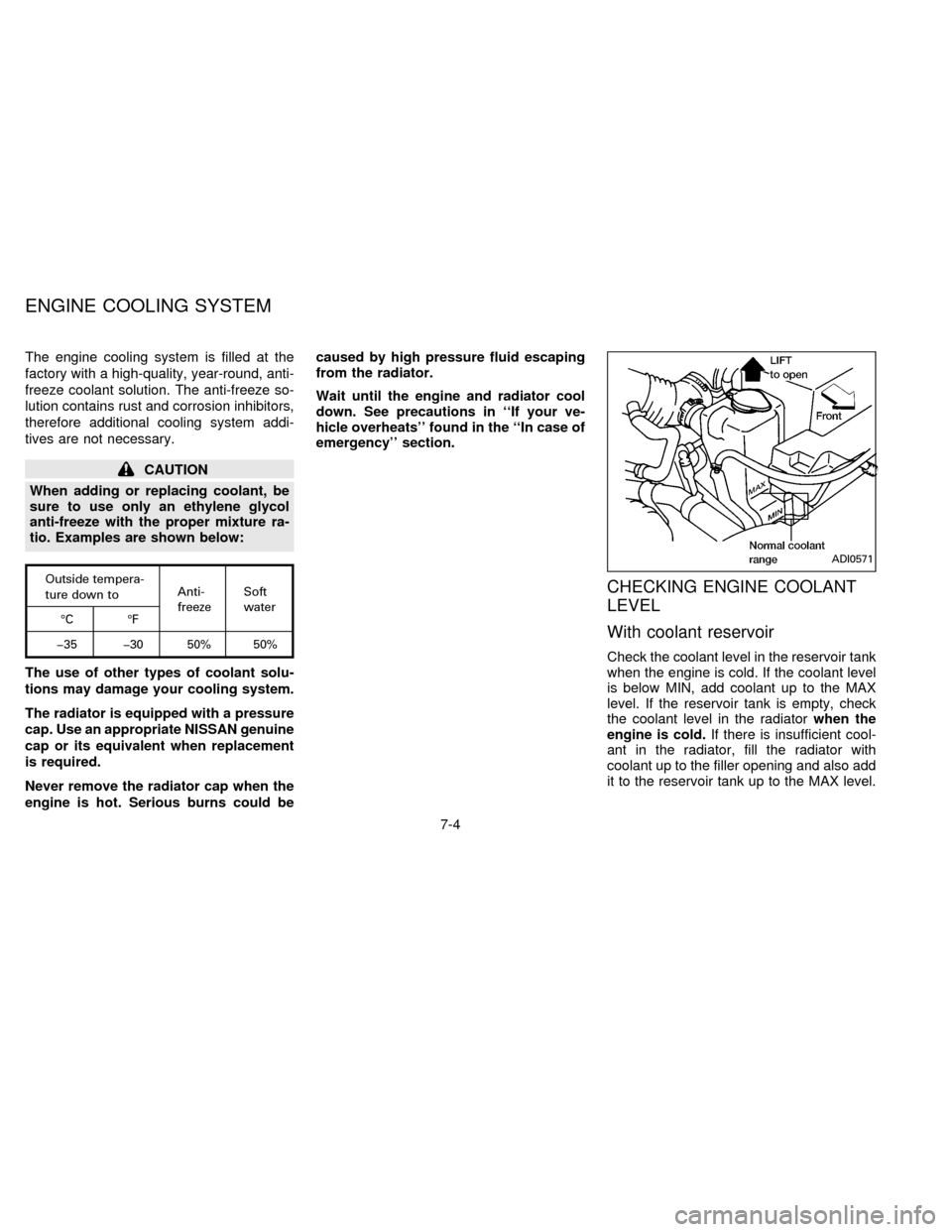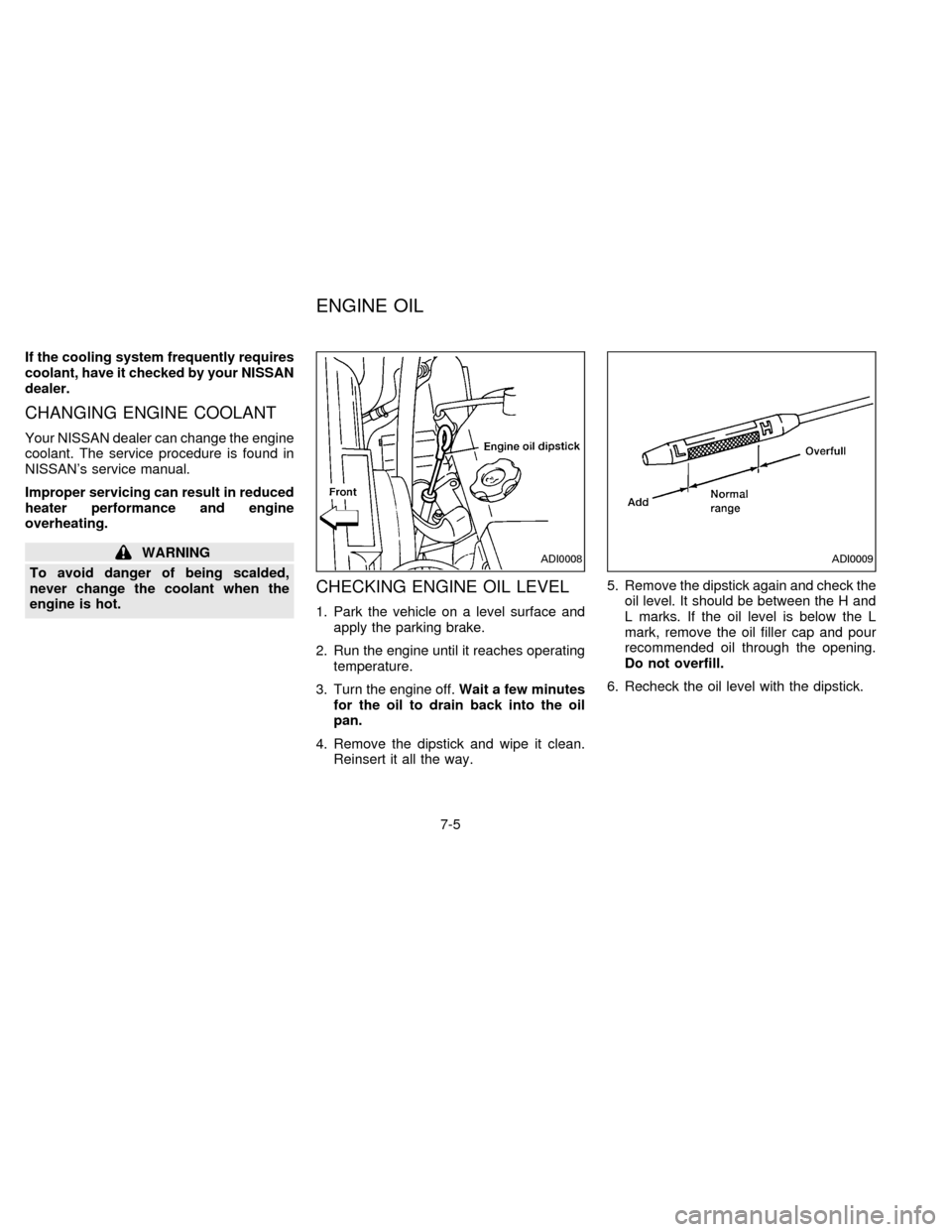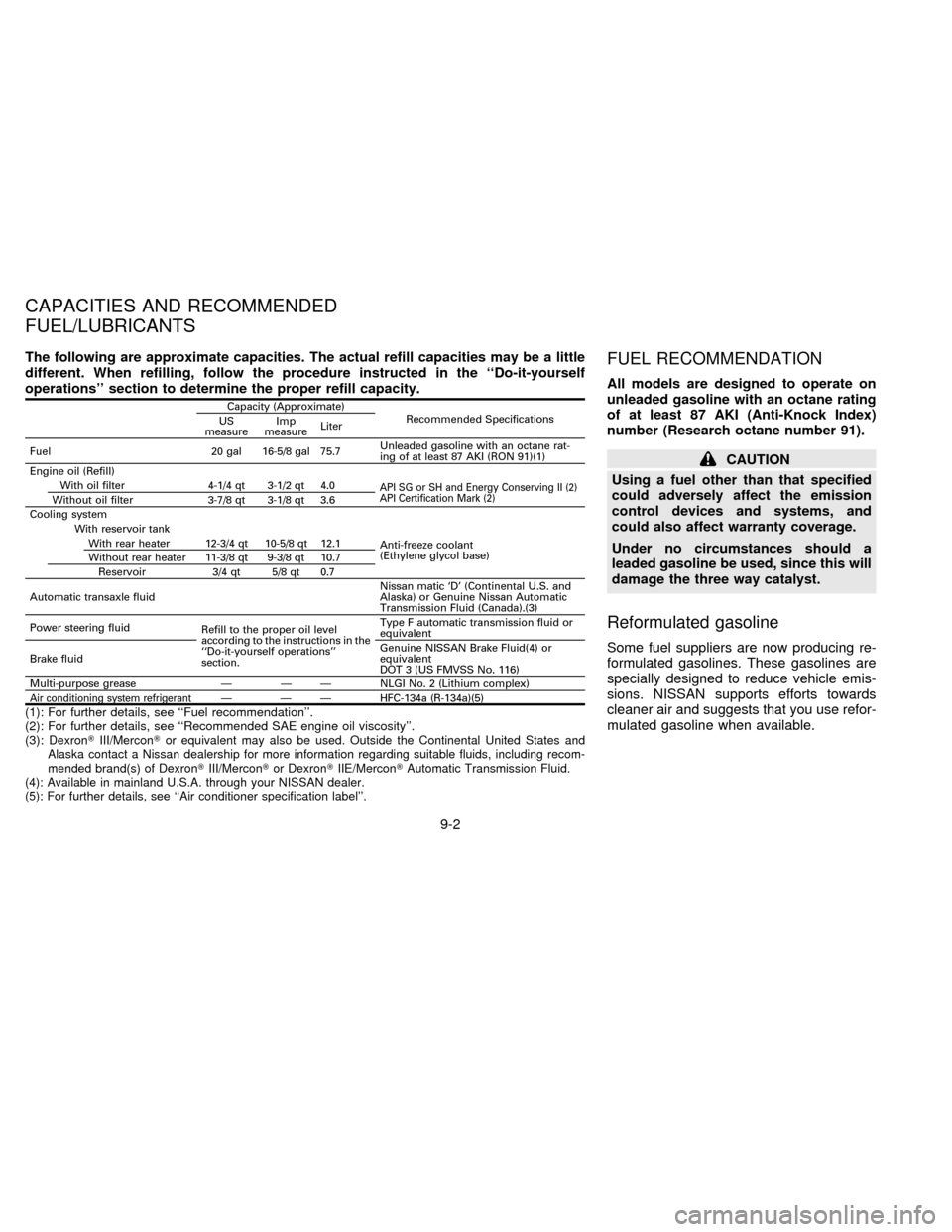1996 NISSAN QUEST cooling
[x] Cancel search: coolingPage 169 of 235

When performing any inspection or mainte-
nance work on your vehicle, always take
care to prevent serious accidental injury to
yourself or damage to the vehicle. The
following are general precautions which
should be closely observed.
cPark the vehicle on a level surface,
apply the parking brake securely and
block the wheels to prevent the ve-
hicle from moving. Move the gearshift
lever to neutral (N).
cBe sure the ignition key is OFF when
performing any replacement or repair.
cDo not work under the hood while the
engine is hot. Turn off the engine and
wait until it cools down.
cBe sure to turn the ignition key to the
OFF or LOCK position. When the igni-
tion key is in the ON or ACC position,
the cooling fan may start to operate
suddenly even when the engine is not
running.
cIf you must work with the engine run-
ning, keep your hands, clothing, hair
and tools away from moving fans,
belts and any other moving parts.cIt is advisable to remove ties and any
jewelry, such as rings, watches, etc.
before working on your vehicle.
cIf you must run the engine in an en-
closed space such as a garage, be
sure there is proper ventilation for
exhaust gases.
cNever get under the vehicle while it is
supported only by a jack. If it is nec-
essary to work under the vehicle, sup-
port it with safety stands.
cKeep smoking materials, flame and
sparks away from fuel and the battery.
cNever connect or disconnect either
the battery or any transistorized com-
ponent connector while the ignition is
on.
cOn gasoline engine models with the
multiport fuel injection (MFI) system,
the fuel filter or fuel lines should be
serviced by a NISSAN dealer because
the fuel lines are under high pressure
even when the engine is off.
cFailure to follow these or other com-
mon sense guidelines may lead to
serious injury or vehicle damage.cImproperly disposed motor oil and/or
other vehicle fluids can hurt the envi-
ronment. Always conform to local
regulations for disposal of vehicle
fluid.
This ``Do-it-yourself operations'' section
gives instructions regarding only those
items which are relatively easy for an owner
to perform.
You should be aware that incomplete or
improper servicing may result in operating
difficulties or excessive emissions, and
could affect your warranty coverage.If in
doubt about any servicing, have it done
by your NISSAN dealer.
MAINTENANCE
PRECAUTIONS
7-2
ZX
Page 171 of 235

The engine cooling system is filled at the
factory with a high-quality, year-round, anti-
freeze coolant solution. The anti-freeze so-
lution contains rust and corrosion inhibitors,
therefore additional cooling system addi-
tives are not necessary.
CAUTION
When adding or replacing coolant, be
sure to use only an ethylene glycol
anti-freeze with the proper mixture ra-
tio. Examples are shown below:
Outside tempera-
ture down toAnti-
freezeSoft
water
ÉC ÉF
þ35 þ30 50% 50%
The use of other types of coolant solu-
tions may damage your cooling system.
The radiator is equipped with a pressure
cap. Use an appropriate NISSAN genuine
cap or its equivalent when replacement
is required.
Never remove the radiator cap when the
engine is hot. Serious burns could becaused by high pressure fluid escaping
from the radiator.
Wait until the engine and radiator cool
down. See precautions in ``If your ve-
hicle overheats'' found in the ``In case of
emergency'' section.
CHECKING ENGINE COOLANT
LEVEL
With coolant reservoir
Check the coolant level in the reservoir tank
when the engine is cold. If the coolant level
is below MIN, add coolant up to the MAX
level. If the reservoir tank is empty, check
the coolant level in the radiatorwhen the
engine is cold.If there is insufficient cool-
ant in the radiator, fill the radiator with
coolant up to the filler opening and also add
it to the reservoir tank up to the MAX level.
ADI0571
ENGINE COOLING SYSTEM
7-4
ZB13-DX
Page 172 of 235

If the cooling system frequently requires
coolant, have it checked by your NISSAN
dealer.
CHANGING ENGINE COOLANT
Your NISSAN dealer can change the engine
coolant. The service procedure is found in
NISSAN's service manual.
Improper servicing can result in reduced
heater performance and engine
overheating.
WARNING
To avoid danger of being scalded,
never change the coolant when the
engine is hot.
CHECKING ENGINE OIL LEVEL
1. Park the vehicle on a level surface and
apply the parking brake.
2. Run the engine until it reaches operating
temperature.
3. Turn the engine off.Wait a few minutes
for the oil to drain back into the oil
pan.
4. Remove the dipstick and wipe it clean.
Reinsert it all the way.5. Remove the dipstick again and check the
oil level. It should be between the H and
L marks. If the oil level is below the L
mark, remove the oil filler cap and pour
recommended oil through the opening.
Do not overfill.
6. Recheck the oil level with the dipstick.
ADI0008ADI0009
ENGINE OIL
7-5
ZB13-DX
Page 175 of 235

WARNING
cWhen engine is running, keep hands
and clothing away from any moving
parts such as cooling fan and drive
belt.
cAutomatic transmission fluid is poi-
sonous and should be stored care-
fully in marked containers out of the
reach of children.TEMPERATURE CONDITIONS
FOR CHECKING
cCheck the fluid level using the HOT
range on the dipstick after the following
conditions have been met:
Ð The engine is warmed up to operating
temperature.
Ð The vehicle is driven at least 15 minutes.
Ð The automatic transmission fluid is
warmed to between 150ÉF and 170ÉF
(66ÉC to 77ÉC).
cThe fluid can be checked at fluid tem-peratures of 70ÉF to 95ÉF (21ÉC to 35ÉC)
using the COLD range on the dipstick
after the engine is warmed up and before
driving. However, the fluid should be
re-checked using the HOT range.
1. Park the vehicle on a level surface and
set the parking brake.
2. Start the engine and then move the gear-
shift lever through each gear range, end-
ing in P (Park) after you have moved it
through all ranges.
ADI0582ADI0572ADI0573
AUTOMATIC TRANSMISSION
FLUID
7-8
ZB13-DX
Page 211 of 235

The following are approximate capacities. The actual refill capacities may be a little
different. When refilling, follow the procedure instructed in the ``Do-it-yourself
operations'' section to determine the proper refill capacity.
Capacity (Approximate)
Recommended Specifications
US
measureImp
measureLiter
Fuel 20 gal 16-5/8 gal 75.7Unleaded gasoline with an octane rat-
ing of at least 87 AKI (RON 91)(1)
Engine oil (Refill)
With oil filter 4-1/4 qt 3-1/2 qt 4.0
API SG or SH and Energy Conserving II (2)
API Certification Mark (2)Without oil filter 3-7/8 qt 3-1/8 qt 3.6
Cooling system
With reservoir tank
With rear heater 12-3/4 qt 10-5/8 qt 12.1
Anti-freeze coolant
(Ethylene glycol base)
Without rear heater 11-3/8 qt 9-3/8 qt 10.7
Reservoir 3/4 qt 5/8 qt 0.7
Automatic transaxle fluidNissan matic `D' (Continental U.S. and
Alaska) or Genuine Nissan Automatic
Transmission Fluid (Canada).(3)
Power steering fluid
Refill to the proper oil level
according to the instructions in the
``Do-it-yourself operations''
section.Type F automatic transmission fluid or
equivalent
Brake fluidGenuine NISSAN Brake Fluid(4) or
equivalent
DOT 3 (US FMVSS No. 116)
Multi-purpose grease Ð Ð Ð NLGI No. 2 (Lithium complex)
Air conditioning system refrigerantÐ Ð Ð HFC-134a (R-134a)(5)(1): For further details, see ``Fuel recommendation''.
(2): For further details, see ``Recommended SAE engine oil viscosity''.
(3):
DexronTIII/MerconTor equivalent may also be used. Outside the Continental United States and
Alaska contact a Nissan dealership for more information regarding suitable fluids, including recom-
mended brand(s) of DexronTIII/MerconTor DexronTIIE/MerconTAutomatic Transmission Fluid.
(4): Available in mainland U.S.A. through your NISSAN dealer.
(5): For further details, see ``Air conditioner specification label''.
FUEL RECOMMENDATION
All models are designed to operate on
unleaded gasoline with an octane rating
of at least 87 AKI (Anti-Knock Index)
number (Research octane number 91).
CAUTION
Using a fuel other than that specified
could adversely affect the emission
control devices and systems, and
could also affect warranty coverage.
Under no circumstances should a
leaded gasoline be used, since this will
damage the three way catalyst.
Reformulated gasoline
Some fuel suppliers are now producing re-
formulated gasolines. These gasolines are
specially designed to reduce vehicle emis-
sions. NISSAN supports efforts towards
cleaner air and suggests that you use refor-
mulated gasoline when available.
CAPACITIES AND RECOMMENDED
FUEL/LUBRICANTS
9-2
ZX
Page 231 of 235

D
Daytime running light system (Canada
only) ........................................................... 1-13
Defogger switch
Rear window defogger switch .............. 1-12
Dimensions and weights.............................. 9-8
Door locks .................................................... 2-2
Drive belts .................................................. 7-12
Driving
Cold weather driving cautions .............. 4-15
Driving with an automatic transmission .. 4-5
Precautions when driving ..................... 4-13
Precautions when starting and driving ... 4-2
E
Economy - fuel........................................... 4-11
Emission control information label............. 9-10
Emission control system warranty ............. 9-19
Engine .......................................................... 9-7
Before starting the engine ...................... 4-5
Capacities and recommended fuel/
lubricants ................................................ 9-2
Changing engine coolant........................ 7-5
Changing engine oil................................ 7-6
Changing engine oil filter........................ 7-7
Checking engine coolant level ............... 7-4
Checking engine oil level ....................... 7-5
Engine compartment check locations .... 7-3
Engine coolant temperature gauge ........ 1-4
Engine cooling system ........................... 7-4Engine oil ................................................ 7-5Engine oil and oil filter recommendation... 9-4
Engine oil viscosity ................................. 9-5
Engine serial number ............................. 9-9
Starting the engine ................................. 4-8
Exhaust gas (Carbon monoxide) ................. 4-2
F
Five passenger seating ............................. 2-18
Five passenger seating with cargo room .. 2-18
Flashers (See hazard warning flasher switch)
Flat tire ......................................................... 5-2
Flexible seating .......................................... 2-33
Floor mat positioning ................................. 2-17
Floor mat positioning pins ......................... 2-20
Fluid (checking)
Automatic transmission fluid ................... 7-8
Brake fluid............................................. 7-10
Capacities and recommended fuel/
lubricants ................................................ 9-2
Engine coolant ........................................ 7-4
Engine oil ................................................ 7-5
Power steering fluid ................................ 7-9
Window washer fluid ............................ 7-10
F.M.V.S.S. certification label ..................... 9-10
Fuel
Capacities and recommended fuel/
lubricants ................................................ 9-2
Fuel economy ....................................... 4-11
Fuel filler lid and cap ............................ 2-15
Fuel gauge.............................................. 1-5Fuel recommendation ............................. 9-2
Fuses ......................................................... 7-17
Fusible links ............................................... 7-18
G
Gas station information............................ 10-10
Gauge
Engine coolant temperature gauge ........ 1-4
Fuel gauge.............................................. 1-5
Odometer ................................................ 1-4
Speedometer .......................................... 1-4
Tachometer............................................. 1-4
Trip odometer ......................................... 1-4
Gear selection (See shifting)
General maintenance .................................. 8-2
H
Hazard warning flasher switch .................. 1-16
Head restraints .......................................... 2-29
Headlight control switch............................. 1-12
Headlights .................................................. 7-19
Heater
Heater and air conditioner controls ..... 3-11
Rear seat heater and air conditioner ... 3-14
Hood release ............................................. 2-10
I
If your vehicle overheats ............................. 5-9
10-2
ZX